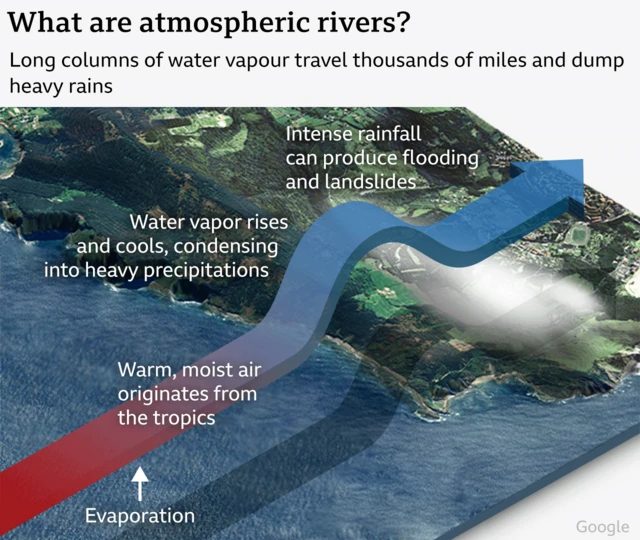Why in the News?
Droughts and fires in South America highlight the importance of “flying rivers” — rain-bearing vapor streams disrupted by Amazon deforestation.

What are Atmospheric Rivers?
- Overview: Long, narrow bands of concentrated water vapour in the lower atmosphere, often termed “rivers in the sky.”
- Dimensions: Typically 2,000–5,000 km long, 400–500 km wide, and about 3 km deep.
- Water Transport: Carry nearly 90% of water vapour across Earth’s mid-latitudes — almost double the Amazon River’s flow.
- Formation: Warm tropical seawater evaporates, and winds transport this moisture; upon encountering land or mountains, vapour condenses into heavy rainfall or snow.
- Role: Unlike short-term weather systems, Atmospheric Rivers (ARs) shape long-term hydrological cycles and trigger extreme precipitation events.
Global Impacts of Atmospheric Rivers:
- Flooding & Extreme Weather: Cause 80% of flood-related damages along the US West Coast; also linked to devastating floods in Europe, Africa, South America, and Australia.
- South America: Amazon’s “flying rivers” disrupted by deforestation, leading to droughts in Peru, Bolivia, and Ecuador; threatens Amazon rainforest’s survival and risks savannisation.
- East Asia: Up to 80% of heavy rainfall events in China, Korea, and Japan during early monsoon linked to ARs.
- Climate Connection: Warming oceans are making ARs longer, wider, and more intense, increasing risks of catastrophic floods and landslides.
- Positive Role: Contribute 30–50% of annual precipitation in some regions (e.g., US West Coast) and help end 33–74% of droughts.
Atmospheric Rivers in India’s Context:
- Interaction: ARs combine with cyclonic circulations and the Himalayan ranges, causing extreme rainfall and flash floods.
- Case Studies:
- 2010 Leh cloudburst (Ladakh) – flash floods and mudslides.
- 2011 Kupwara floods (J&K) – severe AR-driven rainfall.
- Study (1951–2020): Identified 574 AR events during the monsoon season in India.
- Recent Trends: Nearly 80% of India’s most severe floods (1985–2020) linked to AR activity.
- Cause: Rapid Indian Ocean warming intensifies evaporation, moisture transport, and AR-driven floods.
- Impact: Leads to short, intense rainfall spells, landslides, flash floods, crop loss, and mass displacement of communities.
| [UPSC 2024] With reference to “water vapour,” which of the following statements is/are correct?
1. It is a gas, the amount of which decreases with altitude. 2. Its percentage is maximum at the poles. Select the answer using the code given below: Options: (a) 1 only* (b) 2 only (c) Both 1 and 2 (d) Neither 1 and 2 |
Get an IAS/IPS ranker as your 1: 1 personal mentor for UPSC 2024

